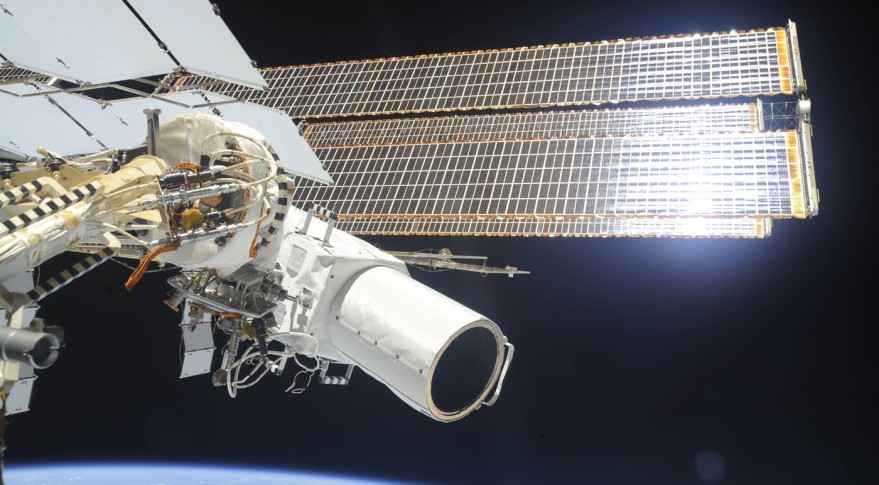UrtheCast Releases High-Definition Video From Space Station Camera

NEW YORK — UrtheCast, the Canadian company that operates commercial cameras on the International Space Station, released June 17 the first high-definition video taken by one of its cameras there.
The videos, taken of several cities, including Boston, London, and Barcelona, Spain, are intended to demonstrate that the company's high-resolution camera has overcome technical problems and is ready to enter commercial service.
"We've been doing a lot of work to make the pointing platform more stable. It was one of the early issues we had," said George Tyc, chief technology officer of Vancouver-based UrtheCast, in a media briefing here June 16. That work included software updates to the pointing platform itself as well as to the image processing pipeline on the ground. [UrtheCast Views of Earth from Space (Photos)]
The camera, called Iris, was one of two installed on the Russian segment of the ISS by cosmonauts in January 2014. A medium-resolution camera, which provides images at 5 meters per pixel, entered commercial service last year, but problems with the pointing platform for Iris delayed its commissioning.
The pointing platform is required for Iris so it can aim at a specific target as the ISS passes overhead. Tyc said the camera can focus on a specific location for about a minute, depending on the path of the station relative to that point on the ground.
Boston, U.S.A. from UrtheCast on Vimeo.
While Iris can take still images at a resolution of one meter per pixel, the company is emphasizing the camera's ability to take video. That video, UrtheCast Chief Executive Scott Larson said, could be used in a variety of applications, from monitoring traffic flows to activity at ports. "This video is entirely unique," he said.
Get the Space.com Newsletter
Breaking space news, the latest updates on rocket launches, skywatching events and more!
UrtheCast is not the first, however, to offer video from space. Skybox Imaging demonstrated in late 2013 the ability to provide high-resolution video from its SkySat-1 satellite. NASA's High Definition Earth Viewing (HDEV) camera, also mounted on the ISS, streams high-definition video. NASA coincidentally announced June 16 that HDEV video is now available in Ultra HD, or 4K, format.
Tyc said that Iris is more capable than Skybox's camera, with a larger field of view and the ability to provide color video. "Nobody has video of this color, this resolution, this size," he said. UrtheCast, company officials added, also has an agreement with NASA to host HDEV video on the company's servers to augment data from its own cameras.
Larson said the camera should reach initial operating capability by late July, at which point the company will start selling images and video from it. UrtheCast is selling imagery directly to customers, as well as working with a network of 16 to 18 distributors around the world who resell UrtheCast imagery.
Initial interest in the company's imagery has been promising, Larson said. "It's a spectrum of people we would have never imagined," he said, ranging from agriculture and natural resources applications to entertainment and media. The company is also providing a platform to allow customers to access the imagery through standard programming interfaces and combine it with other data sets.
The commissioning of the high-resolution camera comes at a critical time for the company. UrtheCast reported net income of $250,000 in the first quarter of 2015, but that included a $2.25 million payment from a business interruption insurance policy triggered by delays in the commissioning of the camera. Those insurance payments ended in May, according to the company's financial statements.
Larson said UrtheCast was ramping up its sales efforts as the high-resolution camera goes online. That effort, he said, should not result in significant additional costs to the company. "It is kind of a fixed-cost business. You have to have all of the people, the systems, and the infrastructure to get to where we are right now, and then you turn on revenue," he said.
UrtheCast is also working on two next-generation systems, an L- and X-band synthetic aperture radar and a camera with a resolution of 0.5 meters, to be installed in a few years on the U.S. segment of the ISS. Tyc said UrtheCast is developing the radar in-house, leveraging expertise from past work on the Radarsat series of spacecraft developed by Canada's MDA Corp. The company plans to announce the prime contractor for the camera in the near future.
Larson acknowledged that UrtheCast was in a crowded field, with several other companies, including Skybox, Planet Labs, and BlackSky Global, planning to develop constellations of commercial remote sensing satellites. "There are three or four companies that are doing all they can to change the cost of the space asset, and UrtheCast is one of them," he said.
"We think there's room for lots of people," he added. "The reality is that it's hard to get imagery from space. There's much more demand than there is supply."
This story was provided by SpaceNews, dedicated to covering all aspects of the space industry.
Join our Space Forums to keep talking space on the latest missions, night sky and more! And if you have a news tip, correction or comment, let us know at: community@space.com.

Jeff Foust is a Senior Staff Writer at SpaceNews, a space industry news magazine and website, where he writes about space policy, commercial spaceflight and other aerospace industry topics. Jeff has a Ph.D. in planetary sciences from the Massachusetts Institute of Technology and earned a bachelor's degree in geophysics and planetary science from the California Institute of Technology. You can see Jeff's latest projects by following him on Twitter.










